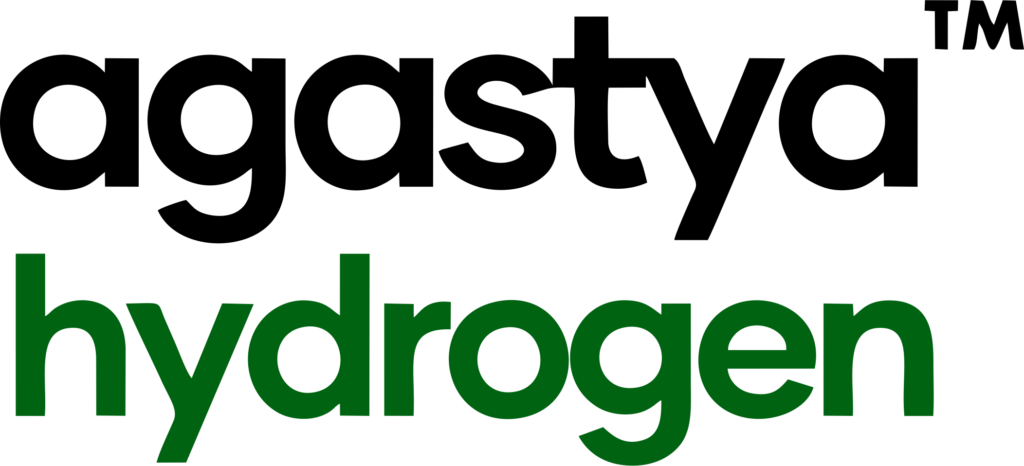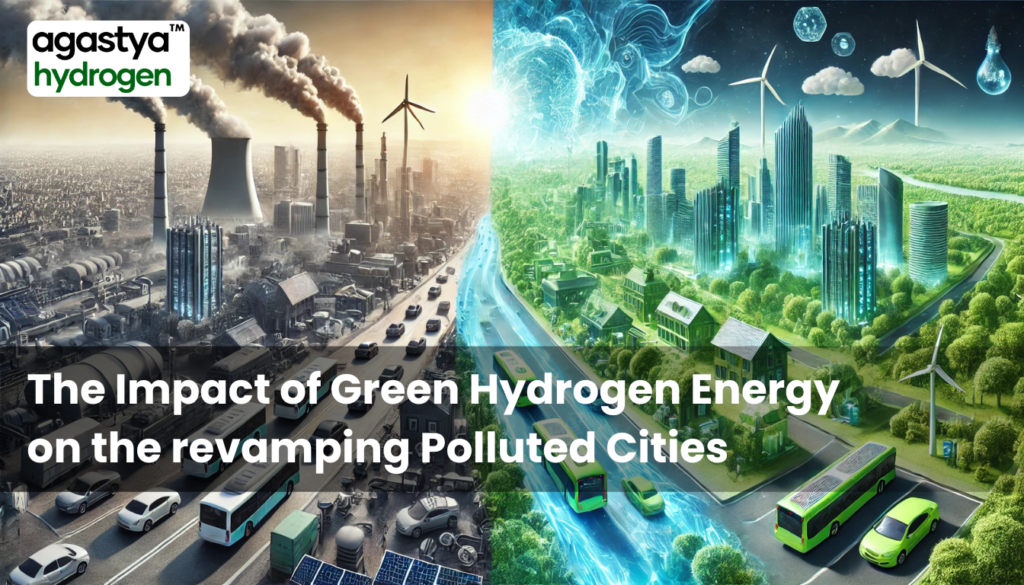Dear Readers, Let’s understand key aspects of The Impact of Green Hydrogen Energy on Revamping Polluted Cities: How Agastya Hydrogen Innovation is Contributing to Building Green Future Societies.
As cities across the globe face the growing challenges of pollution, climate change, and industrialization, innovative solutions are necessary to create cleaner, more sustainable urban spaces. One of the most promising solutions is green hydrogen energy, a renewable and carbon-neutral fuel that can play a key role in reducing pollution in cities. Green hydrogen can significantly contribute to revamping urban areas by cleaning the air, powering industries, and fueling transportation, while also helping to combat the effects of climate change.
In this post, we’ll dive into how green hydrogen works, the positive impacts it can have on cities, and how Agastya Hydrogen Innovation’s AEM Electrolyzer and Hydrogen Refueling Stations (HRS) are advancing this transformation. Additionally, we will explore how some of the world’s most polluted cities can benefit from adopting green hydrogen technologies.
What is Green Hydrogen?
Green hydrogen is produced through a process called electrolysis, where electricity from renewable sources like wind or solar power is used to split water into hydrogen and oxygen. Unlike traditional hydrogen production, which relies on fossil fuels and emits harmful gases, green hydrogen is carbon-neutral because it doesn’t produce any CO2 emissions.
As a result, green hydrogen is a clean and sustainable energy solution that can decarbonize industries, and power transportation, and reduce the overall carbon footprint of cities.
The Role of Green Hydrogen in Revamping Polluted Cities
1. Reducing Industrial Emissions
Industries are major contributors to air pollution in cities. Factories and manufacturing plants often rely on fossil fuels, emitting carbon dioxide (CO2), sulfur dioxide (SO2), and nitrogen oxides (NOx). According to the International Energy Agency (IEA), industrial activities account for about 20% of global carbon emissions.
By replacing fossil fuels with green hydrogen in industrial processes like steelmaking, cement production, and chemical manufacturing, cities can dramatically cut down their emissions. In fact, the HYBRIT project in Sweden is already using hydrogen to produce steel without CO2 emissions, aiming to eliminate all emissions from the steel industry by 2045.
2. Clearing the Air in Urban Areas
Air pollution from transportation is another significant issue in many cities. Vehicles powered by gasoline and diesel emit harmful pollutants that contribute to smog and respiratory problems. According to the International Transport Forum, transportation accounts for nearly 30% of global CO2 emissions.
Hydrogen-powered vehicles, such as buses, trucks, and trains, produce zero emissions—only water vapor. Germany’s hydrogen-powered Coradia iLint trains are a prime example of how hydrogen can replace diesel engines, reducing pollution and improving air quality. Cities that adopt hydrogen-powered transportation can significantly reduce the environmental and health impacts of air pollution.
3. Energy Storage and Grid Flexibility
Green hydrogen can also help cities manage their renewable energy supply. Renewable sources like solar and wind are intermittent, meaning they don’t generate energy all the time. To ensure a reliable energy supply, surplus energy can be used to produce hydrogen, which can then be stored and converted back into electricity when demand is high.
This ability to store and dispatch energy makes hydrogen a valuable tool for stabilizing electricity grids and supporting the shift to 100% renewable energy in urban areas. According to the Hydrogen Council, green hydrogen could provide up to 18% of global energy needs by 2050.
4. Job Creation and Economic Growth
As cities adopt green hydrogen technologies, they create new jobs and stimulate local economies. The development of hydrogen production facilities, refueling infrastructure, and the hydrogen-powered transport sector offers employment opportunities in research, manufacturing, and maintenance. The International Renewable Energy Agency (IRENA) estimates that the hydrogen sector could create over 30 million jobs globally by 2050, helping cities build a sustainable future while also driving economic growth.
How the Most Polluted Cities Can Benefit from Green Hydrogen
Many cities around the world are facing extreme levels of air pollution, which poses serious health risks to residents. However, the adoption of green hydrogen technology can significantly improve their environmental conditions, making them more habitable. Let’s explore some of the most polluted cities and how green hydrogen can help mitigate pollution:
1. New Delhi, India
New Delhi is often ranked as one of the most polluted cities globally, with hazardous levels of air pollution due to industrial emissions, vehicle exhaust, and crop burning. According to the World Air Quality Report, the air quality index (AQI) in Delhi regularly exceeds hazardous levels, causing respiratory issues and other health problems for residents.
By adopting green hydrogen-powered vehicles, New Delhi could significantly reduce emissions from its transportation sector, which is a major contributor to air pollution. Additionally, hydrogen could be used in industries like steel and cement manufacturing, helping to reduce CO2 emissions and improve air quality. The deployment of Agastya’s AEM Electrolyzer and Hydrogen Refueling Stations (HRS) could support these efforts by enabling clean hydrogen production and efficient refueling infrastructure.
2. Beijing, China
Beijing is another heavily polluted city, facing challenges from both industrial emissions and vehicle pollution. Despite significant efforts to improve air quality, pollution levels remain high, especially during the winter months when coal burning for heating contributes to smog.
Green hydrogen could play a key role in Beijing’s fight against pollution by replacing coal and diesel in industries and transportation. With a well-developed hydrogen refueling network and cost-effective hydrogen production technologies, Beijing could reduce its reliance on coal and fossil fuels, ultimately improving air quality and public health. Agastya’s Hydrogen Refueling Stations could be an integral part of this transition.
3. Lagos, Nigeria
Lagos, one of the largest cities in Africa, is also plagued by air pollution, mainly from vehicles and industrial activities. With rapid urbanization and population growth, the demand for energy and transportation is on the rise, further exacerbating the pollution problem.
Lagos could benefit from the introduction of green hydrogen-powered buses, trucks, and taxis, replacing fossil fuel-powered vehicles and improving air quality. Moreover, green hydrogen production could support the growing demand for energy in Lagos, ensuring a clean, reliable, and sustainable power supply. Agastya’s AEM Electrolyzer could help Lagos produce hydrogen from renewable energy sources like solar and wind, creating a cleaner and more sustainable city.
4. São Paulo, Brazil
São Paulo, Brazil’s largest city, struggles with air pollution, especially from vehicles, industries, and deforestation. Despite efforts to clean the air, São Paulo still faces poor air quality that affects the health of its residents.
By implementing hydrogen-powered public transportation and commercial fleets, São Paulo can make a significant impact on its air quality. Hydrogen can also replace fossil fuels in industries like cement and steel manufacturing. Agastya’s Hydrogen Refueling Stations could help set up a robust hydrogen refueling network in the city, encouraging the use of hydrogen-powered vehicles and further reducing pollution.
Agastya Hydrogen Innovation’s Contribution to Clean Cities
Agastya Hydrogen Innovation is making strides in advancing green hydrogen technology, particularly with their AEM Electrolyzer and Hydrogen Refueling Stations (HRS). These innovations are key to enabling cities to adopt green hydrogen at scale.
1. AEM Electrolyzer: Cost-Effective Green Hydrogen Production
Agastya’s AEM (Anion Exchange Membrane) Electrolyzer is a game-changer in hydrogen production. It uses renewable electricity to split water into hydrogen and oxygen, making it possible to produce green hydrogen without relying on fossil fuels. Unlike traditional electrolyzers, AEM electrolyzers don’t require expensive rare materials, making them more affordable and scalable.
This technology allows cities to produce green hydrogen locally, supporting industrial decarbonization, transportation, and energy storage. Agastya’s electrolyzers play a critical role in making hydrogen production more accessible and affordable for urban areas.
2. Hydrogen Refueling Stations (HRS): Building Hydrogen Infrastructure
For hydrogen-powered vehicles to become a viable option, cities need the infrastructure to refuel them. Agastya’s Hydrogen Refueling Stations (HRS) provide the necessary technology for refueling hydrogen vehicles, including buses, trucks, and cars. These stations enable hydrogen-powered transportation fleets to operate effectively, helping to reduce emissions from urban traffic.
By deploying HRS in cities, Agastya supports the adoption of hydrogen vehicles and ensures that cities have the infrastructure to support a clean transportation system. This infrastructure can be integrated with renewable energy sources to create a fully sustainable hydrogen ecosystem in urban areas.
Conclusion: A Cleaner, Greener Future for Cities
Green hydrogen offers a powerful solution to combat pollution and climate change in cities. By replacing fossil fuels with clean hydrogen in industries, transportation, and energy systems, cities can dramatically reduce their carbon footprint and improve air quality. Agastya Hydrogen Innovation’s AEM electrolyzer and Hydrogen Refueling Stations are paving the way for cities to adopt green hydrogen technology at scale, ensuring that the transition to sustainable energy is both cost-effective and accessible.
As more cities embrace green hydrogen, they will move closer to achieving their sustainability goals, creating cleaner, healthier urban environments. Through continued innovation and investment, green hydrogen can help cities become hubs of sustainability, driving both environmental and economic benefits for generations to come.


